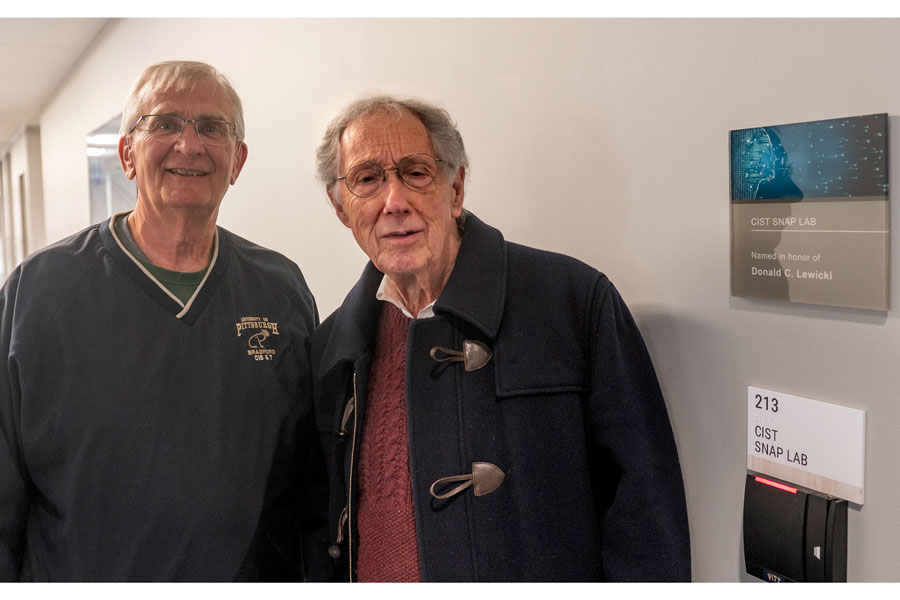Best of both worlds
SNAP lab is both hands-on and high-tech

Before it was open to the public, faculty, staff, students and retirees got a sneak peek inside the George B. Duke Engineering and Information Technologies Building.
Among the most excited was Don Lewicki, founder of the computer information systems and technology program and former supervisor of the Computing, Telecommunications and Media services. Both the academic program and the vital office were moved to the new building, where they have substantially roomier digs.
Lewicki retired in the summer of 2021 when plans for the building were still in the works, but he’d already had a chance to consult on what was needed to help one of the campus’s most popular programs grow even more.
Touring the building’s extensive makerspace that gives information technology students the opportunity to 3D print, solder and print circuit boards, he was asked if it made him want to come out of retirement.
“Yes, it does,” he said after a brief hesitation.
The makerspace is new, but other spaces that computer information systems and technology students use are so much more radically different than the cramped labs they had occupied in the campus’s hangar building as to be unrecognizable.
Later, Lewicki took a private tour with members of the CTM staff who teach in the academic program: Bob Ellison ’99, systems architect; Steve Ellison ’01, systems analyst; and Bill Kline ’86, who succeeded Lewicki as director of CTM Services. They were accompanied by Dr. Ken Wang, who succeeded Lewicki as the director of the academic program, and Dr. Richard E. McDowell, president emeritus and a longtime supporter of the program.
On the ground floor, a room painted black is full of Alienware desktops, individual display screens and large display screens for each pod of five students, which allows them to easily share what they are working on in a group. Instructors have a large display monitor at the front, and at the back is a space with giant screen and track for motion capture and projection of what someone is seeing through virtual reality goggles. This room will be the playground of instructor Jeremy Callinan ’04 and his students as they create, test and evaluate immersive virtual reality and augmented reality applications that are a fast-growing field.
“I can’t even complete a thought because there’s so much going on in here,” Lewicki said. “You’ve got to have a place where students can think and be creative.”
Upstairs is another special lab first envisioned by Lewicki and Steve Ellison, the systems, networks and projects lab, known on campus as the SNAP Lab. “I learned [when I was working] at IBM, that everything has to have an acronym,” Lewicki joked.
Inside, he admired a room with workbenches where no more than a dozen students can work on hardware. Seen through a glass partition in the back of the room are server racks.
“They’re building the back end of the cloud in there,” Steve Ellison said, referring to how his students are creating a small setup that delivers storage space and software remotely.
In the SNAP Lab students in networking classes create a server setup for a small business. Each student has their own “rack” to build their own small server farm. For the final examination, Steve Ellison sabotages the servers with the kinds of problems information technology people deal with all the time – power outages, cyberattacks or a system overload. Students must then repair their creations.
It’s the kind of practical thinking that Lewicki liked to instill in students.
“Everything is hands-on collaboration,” he said. “If you have a good student, you need to give them a good project.”
So, it was only right that as Lewicki toured the new home of the computer information systems and technology program and came across the reimagined SNAP lab, he saw that it was named in his honor.
Lewicki was visibly moved.
“You left us quite a legacy here, Don,” Pitt-Bradford President Richard T. Esch told him.
Lewicki said, “We’ve had a lot of successful students, and I couldn’t be prouder of them.”
One of those former students is Donny Kemick ’04, who is the president and chief executive officer of protocol 80, which started after his graduation as a website design and custom web application development firm to an inbound marketing agency. In May, he and his wife, Amanda Wentworth Kemick ’04, set up the Donald C. Lewicki Technology Fund, which will provide student scholarships.
For more information about the Lewicki Technology Fund or to contribute, contact the Office of Philanthropic and Alumni Engagement at 814-362-5091 or upb.pitt.edu/giving.